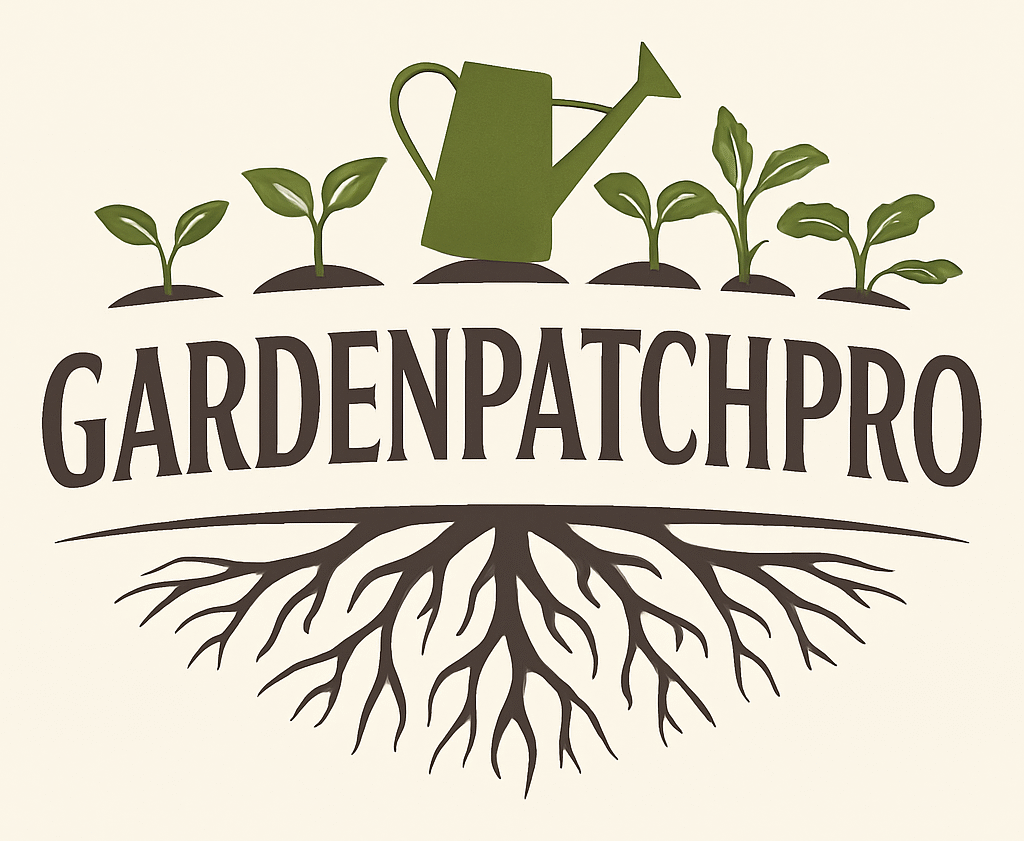14 Drought Tolerant Landscaping Ideas for Sustainable and Low-Maintenance Gardens
Drought-tolerant landscaping offers a practical way to maintain attractive outdoor spaces with less water. It focuses on using plants and materials that thrive in dry conditions, helping to save water and reduce maintenance.

This approach provides a garden that stays healthy and visually appealing while requiring minimal irrigation. Implementing drought-tolerant ideas can benefit both homeowners and the environment, especially in areas with limited rainfall.
1) Use Agave plants for bold, architectural focal points
Agave plants stand out with their strong, geometric shapes. They create eye-catching focal points in any landscape design. Their thick, spiky leaves form dramatic rosettes that add structure to outdoor spaces.
They are drought-tolerant and require little water, making them ideal for dry climates. Their ability to store water in their leaves means they can thrive with minimal care. This helps reduce water use in landscaping.
Agaves work well on their own or paired with other drought-resistant plants like succulents and grasses. Their unique size and texture bring variety to gardens of any scale. Homeowners often use agaves to create modern, desert-style yards or add bold accents to traditional gardens.
2) Incorporate Aloe vera for low-maintenance succulents
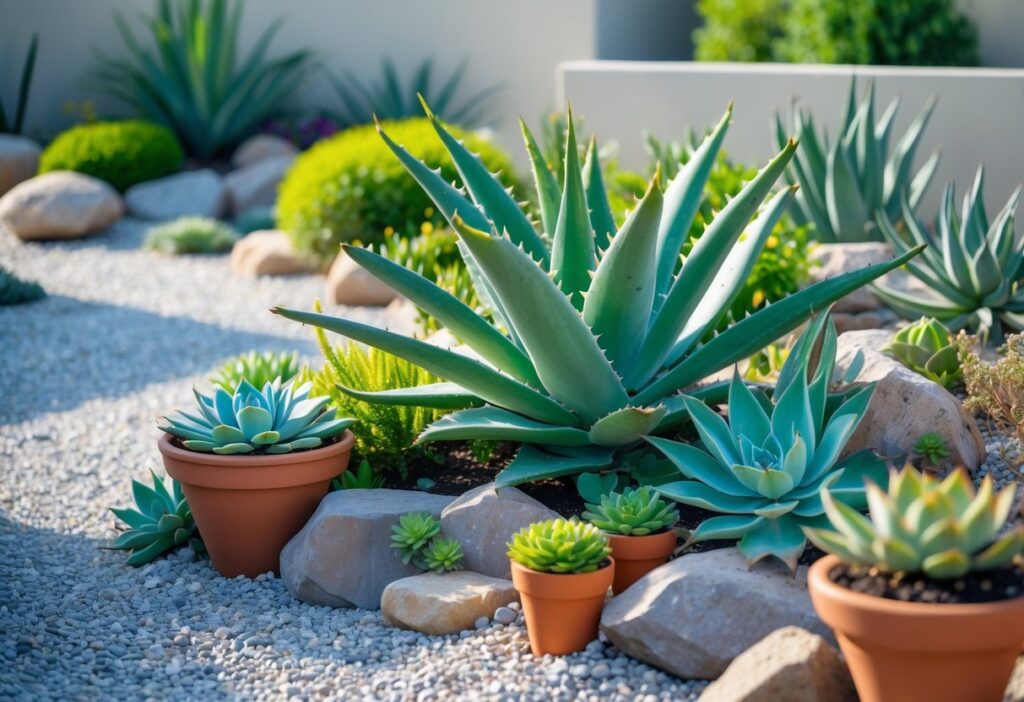
Aloe vera is a strong choice for drought-tolerant landscaping. It requires very little water and thrives in dry, sunny conditions. This makes it ideal for gardens where low maintenance is important.
The plant also adds architectural interest with its thick, spiky leaves. Aloe vera fits well in modern and natural designs. It pairs nicely with other drought-tolerant plants such as agave and yucca.
Because it grows well in well-drained soil, Aloe vera reduces the risk of root rot. It needs only occasional watering, especially during dry spells. This saves time and water compared to traditional plants.
Aloe vera’s versatility makes it useful both in front yards and larger garden areas. It can be planted as a single specimen or grouped with other succulents. Its hardy nature means it will survive in many climates that face water restrictions.
Using Aloe vera in landscaping supports sustainable gardening. It provides beauty without demanding much care or resources. This helps create attractive outdoor spaces that are both practical and eco-friendly.
3) Create rock gardens to reduce water use
Rock gardens are a smart choice for drought-tolerant landscaping. They use stones and drought-resistant plants to create a natural look while cutting down on water needs.
Using rocks reduces the space that needs watering. This lowers overall water use and helps conserve resources.
Plants like succulents, ornamental grasses, and herbs work well in rock gardens. These plants need little water and can survive dry conditions.
Rock gardens also need less maintenance than traditional lawns. They don’t require mowing or frequent watering.
Adding mulch around plants helps keep soil moist longer. It also stops weeds from growing and protects plant roots.
By combining rocks with drought-tolerant plants, a garden can stay healthy and attractive without much water. This approach fits well in dry climates where conserving water is important.
4) Apply thick mulch to retain soil moisture

Applying thick mulch helps keep the soil moist during dry conditions. A layer of 4 inches or more slows down water evaporation and keeps the ground cooler.
Organic materials like straw, shredded leaves, or wood chips work well. These materials not only hold moisture but also improve soil quality as they break down.
It is best to add mulch soon after deep watering. This traps the moisture under the mulch, preventing the soil from drying out too quickly.
Mulching also reduces the need for frequent watering, which is important during drought. It protects plant roots and encourages healthier growth by maintaining steady soil moisture.
5) Install drip irrigation systems for efficient watering
Drip irrigation delivers water directly to the base of plants. This method uses less water than traditional sprinklers by targeting the roots where it is needed most. It helps reduce water waste and keeps plants healthy.
Installing a drip system requires planning the layout for your garden. Choosing quality materials like tubing, emitters, and timers ensures the system works well and lasts longer. Automated timers can make watering easier by controlling when and how much water flows.
Drip irrigation is especially useful for drought-tolerant landscapes. It lowers evaporation and runoff, which saves water during dry periods. This precise watering also reduces weed growth since water is not spread widely over the soil.
Regular maintenance keeps the system efficient. Clearing clogged emitters and checking connections prevent water loss. With proper setup and care, drip irrigation supports sustainable gardening by conserving water and promoting healthy plants.
6) Choose native grasses adapted to dry climates
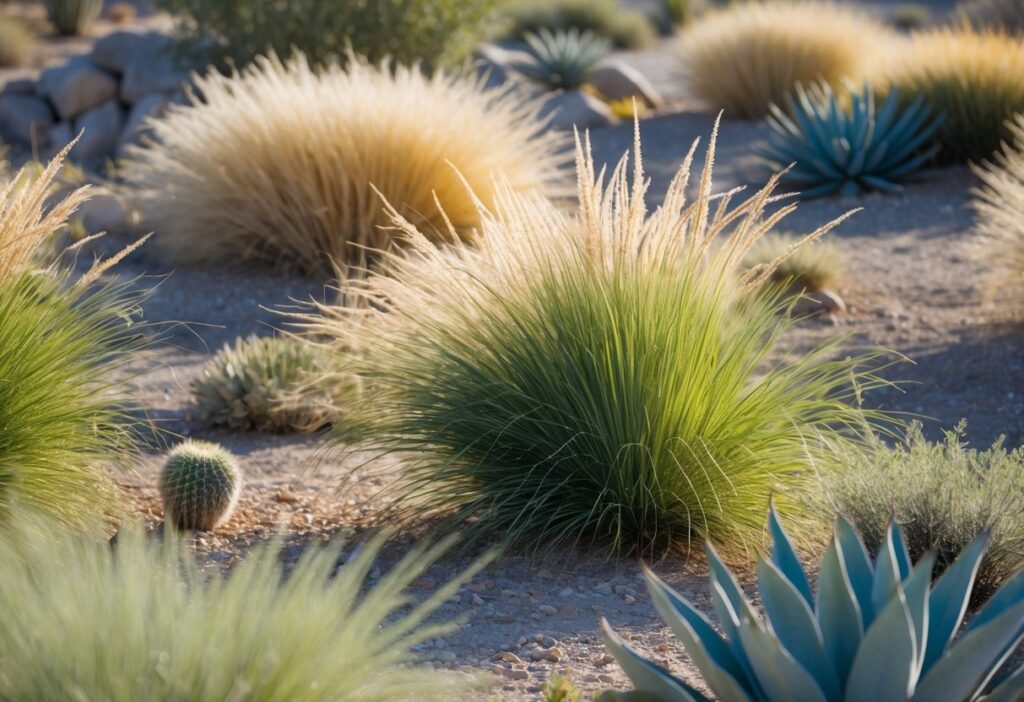
Native grasses are well suited for dry areas because they have evolved to survive with little water. They need less care and can handle heat and drought better than many non-native plants. This makes them a practical choice for drought-tolerant landscaping.
Grasses like little bluestem, switchgrass, and deer grass offer natural beauty and help reduce water use. Many native grasses also provide seasonal color changes, which add interest to the garden through different times of year.
Using native grasses helps create a low-maintenance lawn or garden that stays healthy during dry spells. They also support local wildlife and improve soil health. Choosing grasses adapted to the local climate reduces the need for extra water, fertilizers, and pesticides.
7) Plant ornamental grasses for texture and drought resistance
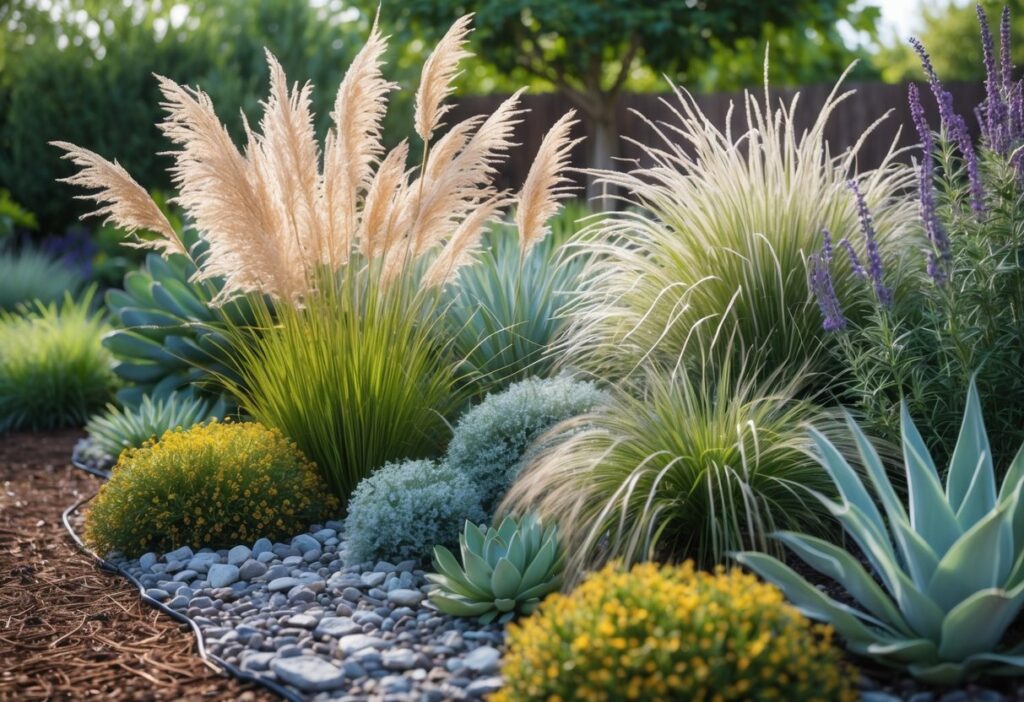
Ornamental grasses are a practical choice for drought-tolerant landscaping. They can thrive with very little water once established, reducing irrigation needs. This makes them ideal for dry climates and areas with water restrictions.
These grasses add texture and movement to a garden. Their slender leaves and seed heads create visual interest throughout the year. They provide contrast to other plants and help fill space without dense watering.
Many varieties, like Mexican Feather Grass, are low-maintenance and suitable for poor or sandy soils. They grow well in full sun and some can tolerate partial shade. It is important to choose species that match the local soil and climate for best results.
Planting ornamental grasses helps create a natural, sustainable landscape. They require little care, stay green or add warm tones in dry months, and support wildlife. Overall, they are a reliable option for anyone looking to save water while keeping the garden attractive.
8) Utilize rain gardens to catch and reuse runoff: front yard drought-tolerant landscaping
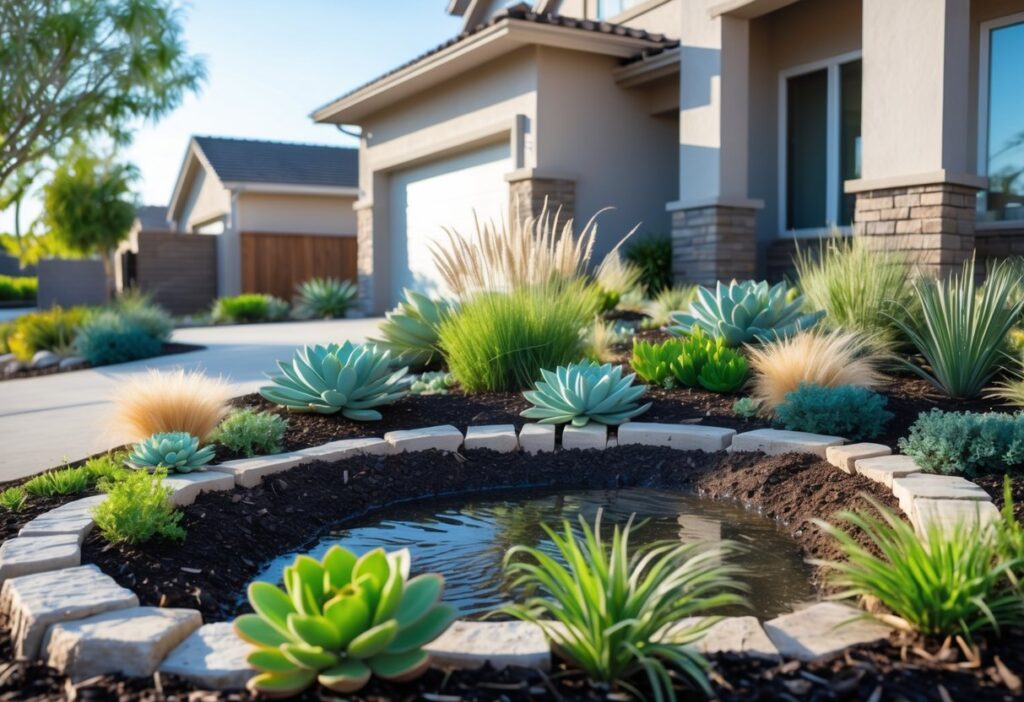
Rain gardens are designed to collect rainwater runoff from roofs, driveways, and other hard surfaces. They help slow down water flow and allow it to soak into the ground naturally. This reduces water waste and protects local waterways.
A well-planned rain garden uses drought-tolerant plants that can handle both wet and dry conditions. These plants absorb water and prevent soil erosion. They also add beauty and support local wildlife.
Installing a rain garden in the front yard helps recycle rainwater. It reduces the need for extra watering during dry periods. This method fits well with drought-tolerant landscaping goals.
Rain gardens can be simple to build using native plants, mulch, and a shallow basin. They can turn unused or low spots in the yard into functional spaces. This promotes sustainable water use with minimal upkeep.
9) Implement xeriscaping techniques to minimize irrigation
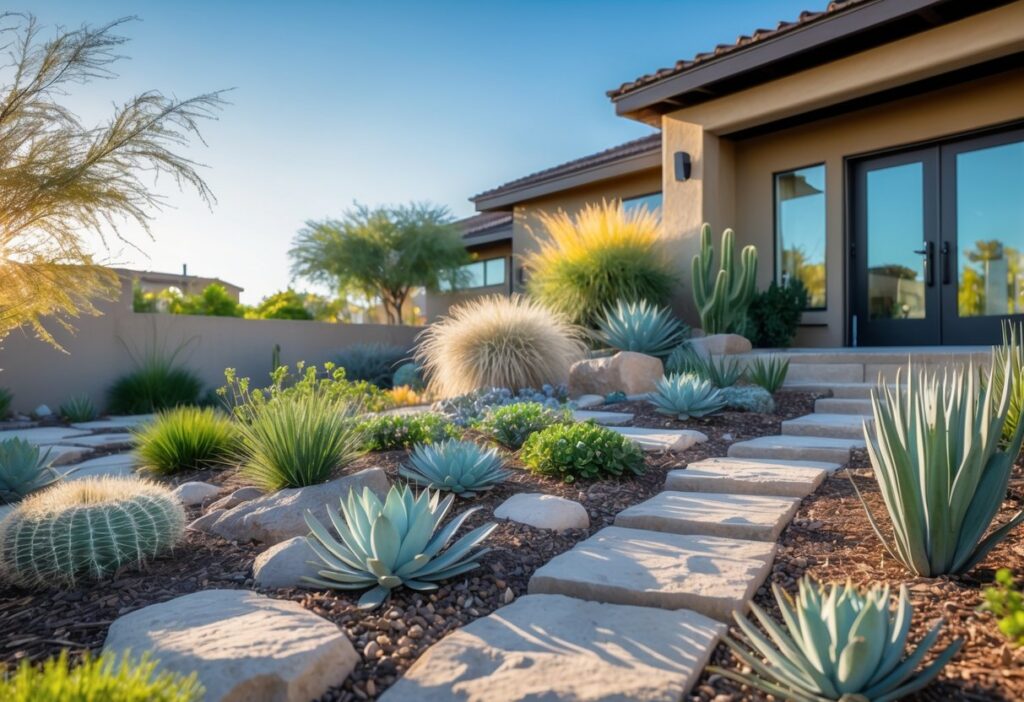
Xeriscaping is a landscaping method designed to reduce the need for watering. It uses plants that are drought-tolerant and adapted to local climates. This helps gardens stay healthy with less irrigation.
The technique also includes using mulch to keep soil moist and reduce evaporation. Efficient irrigation systems, like drip watering, target roots directly and avoid wasting water. This method saves water compared to traditional sprinklers.
Design plays a key role in xeriscaping. Grouping plants with similar water needs together allows for better watering control. It also encourages using native plants, which are more likely to thrive with little extra water.
With these steps, xeriscaping creates attractive yards that use water wisely. It is a practical approach for places with dry climates or water limits. Homeowners can maintain beautiful gardens while conserving resources.
10) Use cacti species for extreme drought tolerance
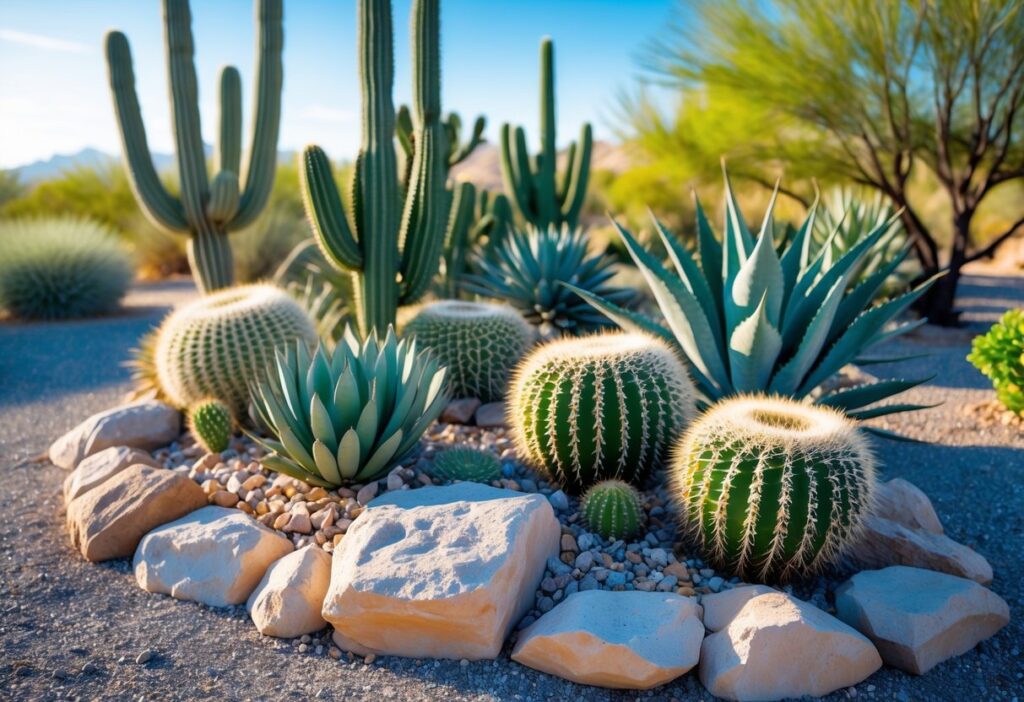
Cacti are well known for their ability to survive in very dry environments. They store water in their thick stems, which helps them last long periods without rain. This makes them ideal for landscapes facing extreme drought.
These plants need very little water once established. They also require well-draining soil to prevent root rot. Using cacti in a garden reduces the need for frequent irrigation.
Different cacti species offer a variety of shapes and sizes. This variety can add texture and visual interest to a dry garden. Cacti work well when combined with rocks or gravel to improve drainage and enhance the look.
Because they are adapted to harsh climates, cacti grow well with minimal care. They are resistant to pests and disease in dry conditions. Using cacti in landscaping creates a durable and low-maintenance outdoor space.
11) Integrate gravel or stone pathways to reduce lawn area
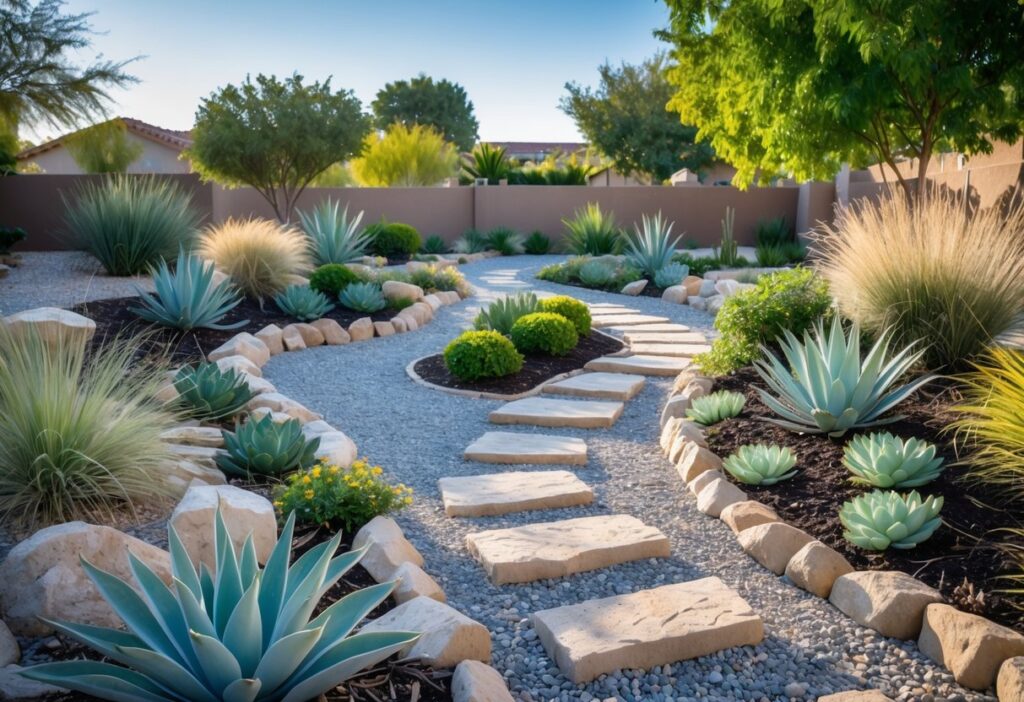
Gravel and stone pathways are practical ways to cut down on lawn space, which lowers water use. These surfaces allow rain to pass through, helping soil stay moist beneath. This approach supports sustainable landscaping by reducing the need for irrigation.
Using natural stepping stones or decorative rocks adds style while keeping the yard low-maintenance. Gravel mulch also helps control weeds and keeps the garden clean. It creates a modern look that works well with drought-tolerant plants.
Combining pathways with drought-resistant plants like succulents or ornamental grasses makes the landscape even more water-efficient. It also makes outdoor areas more accessible without relying on thirsty grass. Gravel and stone paths can transform yards into durable and attractive spaces that require less water.
12) Select drought-resistant flowering perennials like lavender

Lavender is a popular choice for drought-tolerant gardens. It thrives in full sun and well-drained soil. Once established, it needs very little water to survive.
This plant produces purple flower spikes that attract bees, butterflies, and other pollinators. Its fragrant, silvery-green foliage adds color and texture to the garden. Lavender is also deer-resistant, which helps protect it from wildlife damage.
Lavender works well in many landscaping styles. It can be planted in borders, rock gardens, or containers. It is low maintenance and adapts to poor, dry soil without much fuss.
Choosing perennials like lavender helps reduce water use. These plants handle long dry spells better than many other flowering plants. This makes them ideal for areas with limited water or drought conditions.
13) Add drought-tolerant shrubs such as Russian sage
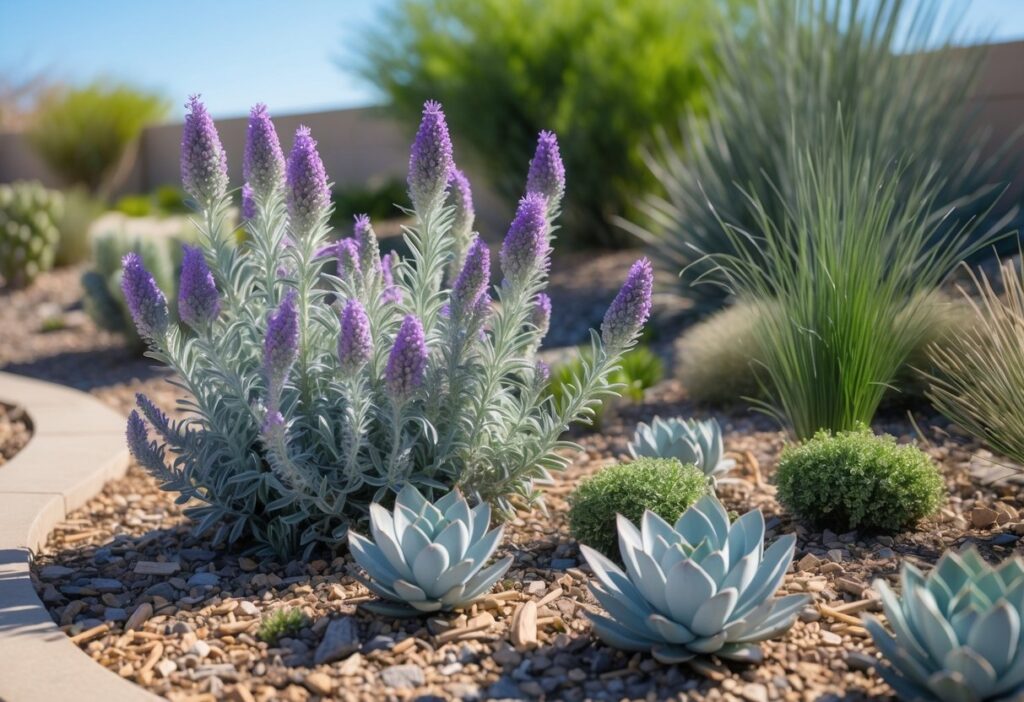
Russian sage is a strong choice for drought-tolerant landscaping. It needs little water once established and can thrive in dry, sunny areas. This makes it a low-maintenance option for gardeners looking to save water.
Its tall, purple flowers and silvery foliage add color and texture to outdoor spaces. Russian sage pairs well with other drought-tolerant plants such as lavender, yarrow, and ornamental grasses. This helps create a varied and interesting landscape.
This shrub also attracts pollinators like bees, which benefits the garden environment. It can be used in front yards or along borders to enhance curb appeal. Adding mulch around Russian sage helps conserve moisture and reduces weeds, improving overall plant health.
14) Design with contrasting plant textures for visual interest

Using a mix of plant textures helps make a drought-tolerant garden more appealing. Combining smooth, spiky, and soft leaves creates a balanced look that draws the eye.
Succulents with thick, pointed leaves work well alongside tall, narrow grasses. This contrast adds depth and height to the landscape without extra water needs.
Adding different textures also gives a more natural feel. Plants like agave and aloe provide bold shapes, while fine ornamental grasses offer a softer touch.
By mixing textures, the garden stays interesting through different seasons. It lets drought-tolerant plants show off their unique forms and colors more clearly.
This method requires little maintenance. It focuses on choosing plants that survive dry conditions while still looking organized and lively.
Overall, contrasting textures are a simple way to improve curb appeal and create lasting visual impact in drought-prone areas.
Benefits of Drought-Tolerant Landscaping

Drought tolerant landscaping offers practical advantages that can help reduce water use, lower long-term expenses, and support the natural environment. It makes outdoor spaces easier to maintain while contributing positively to the surrounding ecosystem.
Water Conservation Advantages
This type of landscaping significantly cuts down on water consumption. By using plants that thrive with little water, irrigation needs drop dramatically. This approach reduces strain on local water supplies, especially in dry regions or during drought periods.
Mulching and drip irrigation systems are often used with drought-tolerant plants to maximize water efficiency. These techniques help retain soil moisture and deliver water directly to plant roots, minimizing evaporation and runoff.
Switching to drought-tolerant landscaping can lower household water use by up to 50%. This not only conserves a precious resource but also helps communities manage water shortages more effectively.
Cost Savings Over Time
Drought-resistant gardens save money on water bills due to reduced irrigation requirements. Over the years, homeowners pay less for watering their lawns and landscapes.
Maintenance costs are also lower because these plants need less fertilizer, pesticides, and mowing. Many drought-tolerant plants are native or adapted to local conditions, making them hardier and less prone to pests and diseases.
Investing in drought-tolerant landscaping can cut down on expensive lawn care services and reduce the need for costly plant replacements. The upfront cost may be higher, but savings accumulate over several seasons.
Supporting Local Biodiversity
Using native and drought-tolerant plants promotes local wildlife habitats. These plants provide food and shelter for pollinators like bees and butterflies, which are vital for ecosystem health.
By planting species naturally suited to the environment, landscapes support a balanced local ecosystem. This reduces the need for chemical treatments that can harm beneficial insects and soil organisms.
Drought-tolerant gardens encourage a diverse range of species and help maintain genetic diversity. They create pockets of natural beauty that sustain wildlife in urban and suburban areas.
Essential Considerations for Planning
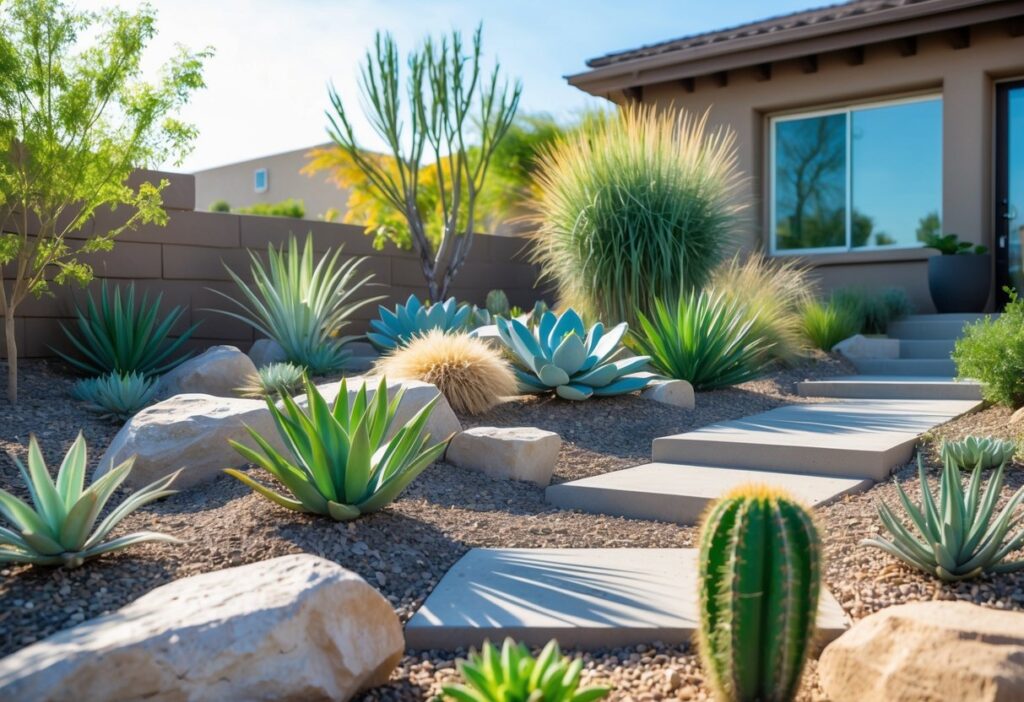
Planning drought-tolerant landscaping requires paying close attention to soil quality, plant selection, and watering methods. These elements work together to create a garden that uses water wisely and thrives in dry conditions.
Soil Preparation and Improvement
Soil quality is key to supporting drought-tolerant plants. Sandy or rocky soils drain water quickly, which can be good, but they may lack nutrients. Adding organic matter like compost improves water retention and provides nutrients.
Testing soil pH helps determine if adjustments are needed. Most drought-tolerant plants prefer neutral to slightly acidic soil. If soil is too alkaline or acidic, amendments like sulfur or lime can balance it.
Mulching is important. It reduces water evaporation, regulates soil temperature, and cuts down on weed growth. Using mulch such as wood chips, gravel, or decomposed granite is beneficial for dry gardens.
Choosing the Right Plants for Your Climate
Selecting plants adapted to the local climate minimizes water needs. Native plants are often the best choice because they have evolved to survive with natural rainfall levels.
Succulents, cacti, and other desert plants handle drought well. However, choosing a variety of plant types adds visual interest and resilience. For example:
- Deep-rooted shrubs manage long dry spells
- Ground covers reduce soil erosion and conserve moisture
- Perennials with small leaves lose less water through transpiration
Understanding local rainfall patterns, soil type, and temperature ranges helps in picking plants that will succeed with little irrigation.
Efficient Irrigation Strategies
Even drought-tolerant plants need some water, especially during establishment. Efficient irrigation conserves water and supports plant health.
Drip irrigation delivers water directly to roots, reducing waste. Timers can schedule watering during cooler parts of the day to limit evaporation.
Collecting rainwater in barrels provides a sustainable water source. Grouping plants with similar water needs together simplifies irrigation and prevents overwatering.
Using mulch around plants also helps keep moisture in the soil longer, reducing the frequency of watering needed.
Frequently Asked Questions
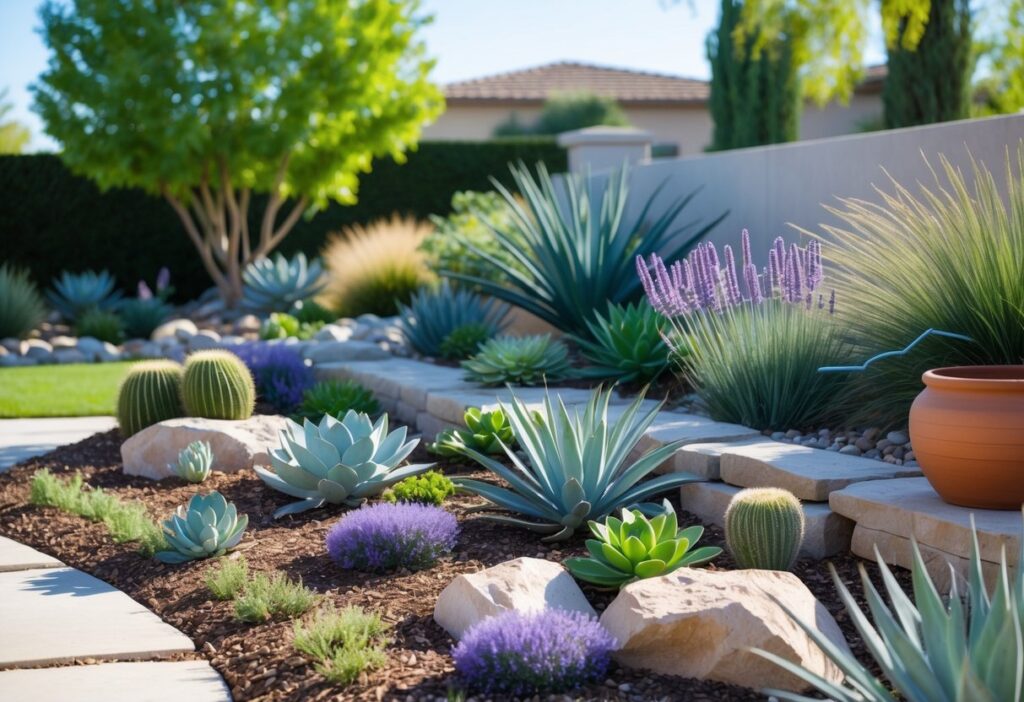
Drought-tolerant landscaping focuses on choosing the right plants, using water-saving methods, and designing spaces that need less care. Effective strategies include selecting hardy plants, applying mulch, and using efficient irrigation systems.
How can I create a low-maintenance, drought-tolerant landscape?
He or she should start by choosing plants like agave and aloe vera that need little water once established. Adding rock gardens helps reduce water use and keeps upkeep simple. Thick layers of mulch will keep the soil moist longer.
What are some cost-effective strategies for drought-resistant landscaping?
Using native or drought-resistant plants cuts down on water needs and maintenance costs. Installing drip irrigation systems delivers water directly to roots, saving water and money. Mulch is inexpensive and helps reduce watering frequency.
Which plants are ideal for a drought-tolerant front yard garden?
Agave plants make bold focal points with their strong shapes. Aloe vera adds easy-care greenery and also has practical uses. Other succulents and cacti work well because they store water and thrive in dry soil.
How is the 70/30 rule applied in designing sustainable gardens?
The 70/30 rule means about 70% of the yard should consist of drought-tolerant plants and hardscape like rocks or mulch. The remaining 30% can be more water-dependent or decorative plants. This balance helps save water and keeps the garden attractive.
What design principles should I follow for a drought-tolerant landscape in Southern California?
Southern California gardens should use plants adapted to hot, dry conditions such as succulents and desert natives. Grouping plants by water needs helps irrigation efficiency. Using rocks and mulch reduces evaporation and maintains soil health.
What are some innovative ideas for a drought-tolerant side yard?
Transform the side yard with rock gardens and vertical plantings like climbing succulents. Adding mulch and drip irrigation provides moisture control without overwatering. Using low plants like aloe vera creates color and texture without needing much space or water.
